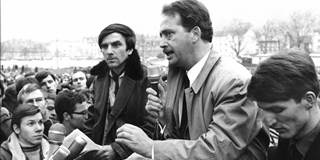In the 1960s, much like today, people with opposing viewpoints struggled to communicate with one another. Yet there was a civility to that era's public debate that is nowhere to be found today, owing to liberal elites' understanding that refusing to engage would only reinforce the “us versus them” mentality that fuels radicalism.
BERLIN – In many Western countries today, social and political divisions have widened to the point that attempting to bridge them seems futile. Yet one might have believed the same thing in the 1960s, an era at least as conflicted as ours. And yet those divisions were ultimately overcome. The difference was the discourse.
In the 1960s, memories of the horrors of World War II still hung heavy over Europe. In Germany, the still-fragile democratic order was shaken by radicalism on both the left (communists) and the right (nationalists), which reflected external challenges, such as the Cold War, and internal pressures, including the first post-war recession and rising unemployment. In 1968, student protests erupted in cities across Europe, as well as in the United States, reflecting opposition not only to the Vietnam War, but also – and increasingly – to the “establishment” as such.
Much like today, people with opposing viewpoints in the 1960s struggled to communicate with one another. Yet there was a civility to that era’s public debate that is nowhere to be found today. It was understood, at least by some, that refusing to engage would only reinforce the “us versus them” mentality that fuels radicalism.

BERLIN – In many Western countries today, social and political divisions have widened to the point that attempting to bridge them seems futile. Yet one might have believed the same thing in the 1960s, an era at least as conflicted as ours. And yet those divisions were ultimately overcome. The difference was the discourse.
In the 1960s, memories of the horrors of World War II still hung heavy over Europe. In Germany, the still-fragile democratic order was shaken by radicalism on both the left (communists) and the right (nationalists), which reflected external challenges, such as the Cold War, and internal pressures, including the first post-war recession and rising unemployment. In 1968, student protests erupted in cities across Europe, as well as in the United States, reflecting opposition not only to the Vietnam War, but also – and increasingly – to the “establishment” as such.
Much like today, people with opposing viewpoints in the 1960s struggled to communicate with one another. Yet there was a civility to that era’s public debate that is nowhere to be found today. It was understood, at least by some, that refusing to engage would only reinforce the “us versus them” mentality that fuels radicalism.